For many decades, surgical treatment of varicose veins of the leg remains the only radical method to eliminate this disease and its complications.Thanks to modern technologies and improving functioning techniques, it is really effective in both terms and cosmetics, it is performed as easily and painlessly as possible, to be well tolerated by patients and does not cause prolonged disability.

Normally, about 30% of the blood from the lower extremities flow through small subcutaneous venous branches, which join in two central venous drawers - a large and small subcutaneous veins.These vessels are directly connected to the deep veins, through which 70% of the blood flow.In places of such compounds there are valves that pass blood only from surface to deep veins.There are also tens of small veins, also connecting the surface venous network to deep.They also have valves that pass blood in just one direction.The main cause of varicose veins is the failure of venous valves, which leads to improper discharge of blood: from deep veins to the surface, which increases the pressure on them and leads to the expansion of both small vessels and central venous trunks.The main goals for which surgical treatment is aimed at varicose veins of the lower extremities:
- Elimination of blood stagnation in changed surface veins, which will prevent the progression of chronic venous insufficiency and trophic disorders in the skin.
- Removing deformed vessels and varieties that represent a cosmetic defect.
- Elimination of blood discharge from deep veins to superficial ones - bonding and intersection of perforant veins, as well as a large and small subcutaneous veins in their connecting places to deep ones.
- Preventing a repeated appearance of varicose veins.
A special place in the surgical treatment of female varicose veins of the lower extremities belongs to cosmetic surgery.After such interventions, not only pathologically altered veins, but also after surgery on the skin of the legs, or they are unclear.To achieve the maximum cosmetic effect, surgical surgery for varicose veins is performed according to the following methods:
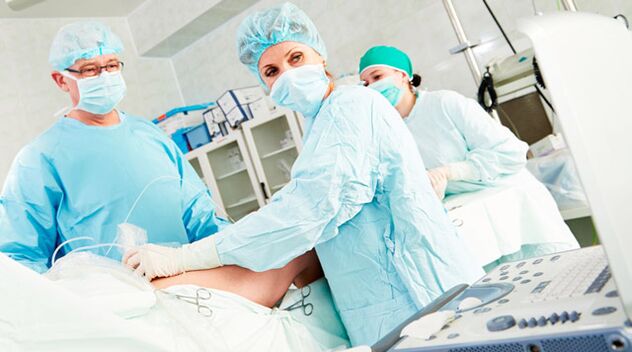
- Laser ablation or radio frequency of combustion veins of central underwear of a large and small subcutaneous vein under the control of ultrasound through a puncture of the skin in the thighs or legs.
- Stem Sclerobliteration and Sclerotherapy - filling large and small subcutaneous veins, as well as all their branches, even the younger, with a special medicine.
With any of the prescribed methods of treatment, varicose veins are not removed but returned from blood vessels to a soft cicatric fabric.Both physical impacts (laser rays, radio frequency waves), and chemical compounds (sclerosants) destroy the inner layer of the vein.Thanks to this, it loses the lumen, the adhesions and completely desert from the blood, turning into an ordinary (cyclic) connective tissue.Thus, without the direct removal of the veins, all the goals set to the rapid treatment of the varicose veins of the lower extremities are achieved - the changed vessels are eliminated, and the dangerous consequences of venous insufficiency are eliminated in them.The sole restriction of cosmetic operations in the treatment of varicose veins in women is only possible to expand slightly or limited to 1-2 degrees.During pregnancy and in the early postnatal period, surgical treatment is contraindicated with the exception of acute situations that require urgent intervention, for example, with contagious thrombophlebitis.The surgery is limited to the coating of a large subcutaneous vein at the site of its connection to the femor (Crossectomy).Consider the most common surgical interventions in the treatment of varicose veins of the lower extremities: laser ablation, endoscopic dissection of veins and phlebectomy.The latter is divided into the following types:
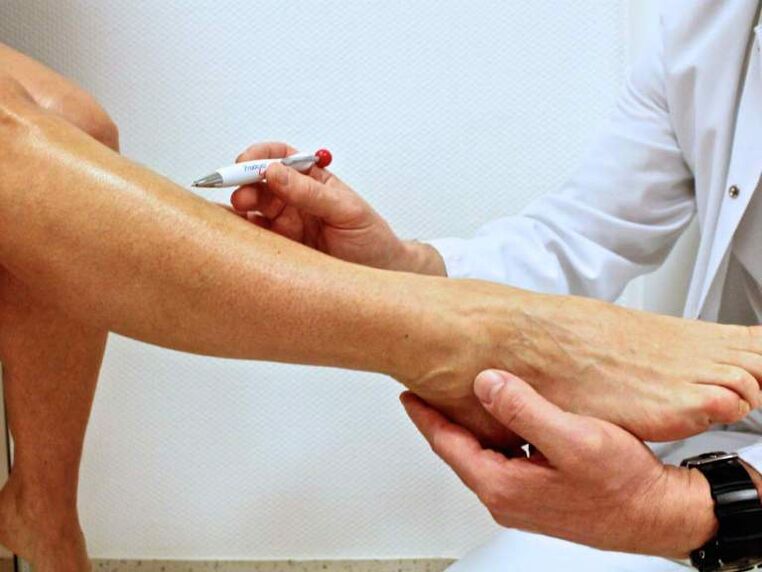
- Classic surgery, or complete stripping or operation of Trojanov-Trendelenburg-Bubko-Narata;
- short strip;
- Phlebectomy.
Flexolectomy
Removal, extraction of veins from under the skin is called phlebectomy.This is one of the first methods of surgical treatment of varicose veins of the lower extremities.But even today, phlebectomy is most often performed by phlebology and vascular surgeons.There are three modifications and methods of operation: full, short, miniflebectomy.Local surgeons call classical phlebectomy Trojanov-Trendelennburg-Bubko-Narat, and foreign authors with full stripping.The volume of the intervention is presented:
- As a bandage of the luggage of a large subcutaneous vein at the site of its union, 2-3 cm in the thigh under the inguinal folding, in the thigh, through a cut.
- Removing it throughout the groin using a special probe through two skin cuttings 1-2 cm along the inner surface near the knee and ankle.
- Removing all varicose veins and small veins through small special cuttings is about 1-2 cm (they can be from 5-6 to 10-20) with wearing perforant bankruptcy vessels.
- Sewing all wounds with cosmetic stitches.
Classic phlebectomy more radically allows you to remove varicose but more traumatic veins among all existing techniques.
Short -loving
With a short stripping, not all the large subcutaneous vein is removed, but only its fragments, affected by varicose veins, for example, only in the thigh or lower leg.Healthy segments are not removed.This reduces the trauma of the intervention, but the risk of relapse remains.Otherwise, operational operations of the surgery are similar to classical phlebectomy.
Flexolectomy
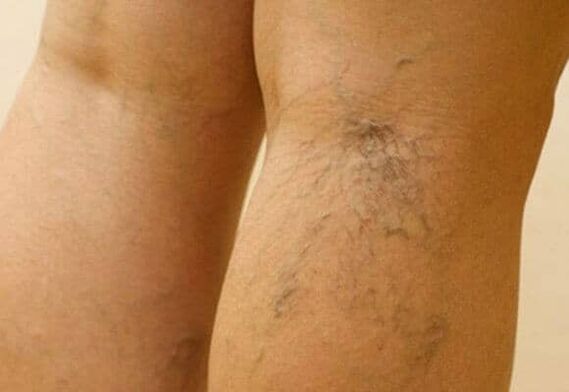
Innovative methodology for removing small varicose veins of a large subcutaneous vein is called phlebectomy.For its implementation, special tools (pronounced scalpel, hooks, clamps, shoulder) are needed, with which veins are extracted through the skin of several millimeters.It is not necessary to sew such skin defects, the wounds are invisible.Most often, surgeons combine a short or full strip of a large subcutaneous vein with a leaflet.Such combined operation combines radicalism and adhesive trauma with a good cosmetic effect.Laser ablation for varicose veins involves burning with a laser beam of a large subcutaneous vein along the entire side of its cleaning.To do this, through the skin of the skin on the thighs or in the ankle area in the vein lumen, a cattle-vendist is presented throughout its length.Under the control of ultrasound, Svetovod is slowly extracted.The laser beam, acting on the venous wall, destroys the inner layer.As a result, Vienna falls and ceases to function, which is clearly visible on the ultrasound monitor.If not only the main venous luggage is affected by varicose veins, but also its branches, they are removed according to the phlebectomy method.
A disease such as varicose veins is a disease characterized by the dysfunction of the vascular walls and the weakness of the valves in the veins, which causes stagnation in the blood vessels of the lower extremities and the appearance of venous joints.Such a pathology is quite dangerous and filled not only with trophic disorders and the presence of an inflammatory process, but also by the lack of tissue food.As a rule, this contributes to the formation of blood clots, which can spread through blood flow throughout the body and the appearance of difficult ulcers to live trophic.Moreover, the formation of thrombotic formations within the vessels threatens the development of a disease such as thrombophlebitis.Therefore, if the patient has varicose veins of the lower extremities, surgical treatment is mandatory, especially if the onset of the disease.I would like to attract the attention of our site readers that the operation for varicose veins of the lower extremities is a radical measure and, as a rule, is described if it cannot do without it.Varicose disease of the lower extremities, surgical treatment includes several, most used in surgical practice options for surgical treatment.These options are directly in access to the removal of the affected vessels and the veins of the lower extremities.
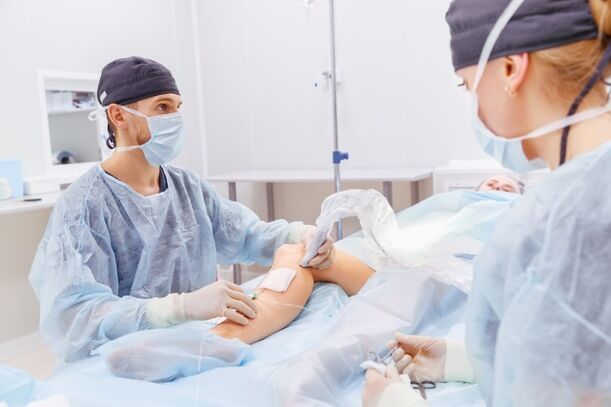
- The use of traditional phlebectomy in surgical practice for radical treatment of varicose veins.This option is carried out in accordance with the methodology of the Bebok.This implies the introduction of a probe specifically created for such a procedure into the vessel lumen and the subsequent vein extract through a predetermined cut on the skin.After surgery, its cord is performed with a cosmetic layer, then making it almost invisible.
- Phlebectomy - such surgery is required to remove small sections of blood vessels and veins, affected by varicose veins.Note that this operation does not provide for cuts on the skin, as part of the affected vessel or vein is removed by puncture on the skin, which requires no imposing layers.
Note that surgical intervention in the treatment of certain diseases is shown far.However, varicose veins of the lower extremities, surgical treatment is extremely necessary if the removal of blood clots and potentially dangerous resources of the inflammatory process is required.This approach will improve the patient's condition and help to avoid severe and unsure of the health and life of the patient's complications.States seeking urgent operation for varicose veins include:
- the presence of thrombophlebitis or risks that provoke its appearance;
- acute thrombophlebitis or frequent irritation of the disease;
- wide loss of blood vessels and veins;
- Constantly disturbing feeling of fatigue and severity in the legs, unpleasant pain, indicating a clearly expressed varicose veins;
- The appearance of trophic ulcers.
There are also some contraindications of operation for varicose veins:
- the second and third trimester of pregnancy;
- the presence of infectious diseases in an acute form;
- the irritation of the pathologies that exist in a patient (diabetes, asthma, peptic ulcer and others);
- myocardial infarction, stroke;
- Dermatological problems.
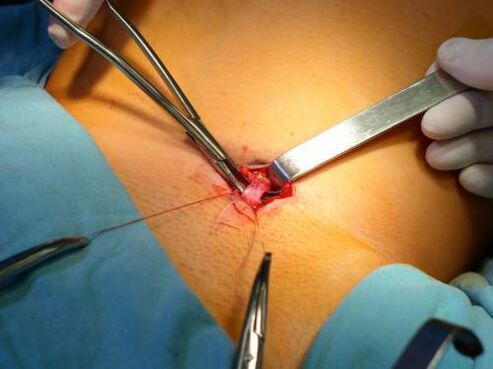
Displacement - as a rule, this method is used in the presence of a small part of the lesion, this is a technique that is more frugal, unlike traditional phlebectomy.The method consists of stretching, through a special stroke, the most venous joint.There are also a species of this technique - cryostropping, which means the sinking of the damaged ship in the cryosond and its subsequent removal.
Sclerosis - The technique predicts the introduction of a damaged sclerosant, a special substance for "gluing" the vessel walls between them.However, after the procedure, the vein does not extend, but remains in place, without fulfilling its purpose, although blood flow through Vienna and stops, however, this function is performed by collateral vessels, which does not violate venous blood flow.The operation is performed under the mandatory control of a specialist with ultrasound equipment.
Laser coagulation - this method is more innovative in the treatment of varicose veins and is the introduction of special equipment with laser radiation (thin probe) into the vein lumen.The device has a cauterizing effect on the blood vessel walls.
Post -surgery consequences to remove varicose veins:
- The appearance of characteristic post -operative hematomas on the surface of the body, which, as a rule, is chosen for several months;
- Also, after a few months, seals under the skin located along the bed of the remote ship disappear;
- Violations of the lymphatic system (blood vessels) of the blood vessels, which can lead to stagnant processes.Such consequences after surgery are treated conservatively, however, the lymph circulation is often restored after several months;
- Possible damage to the subcutaneous nerve ending, which is manifested by impaired epidermis sensitivity-This symptom after surgery passes after 5-6 weeks.
Briefing
Surgery of the disease with varicose
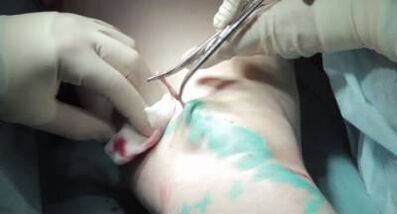
Traditionally, phlebectomy is performed according to the bebcock method and consists of inserting the probe into the vein lumen with the subsequent extension of the vein completely over its length by cutting into the skin outside.The cut is sewn at the end of the operation with a cosmetic layer.Phlebectomy is used to remove very short areas of the vein, during surgery, the veins are not used.Cuttings on the skin are not performed, and a piece of vein is removed through a thin puncture on the skin that does not require imposing layers.With a small area of varicose veins damage, it is possible to perform a softer technique - stripping.This is stretching with a thin stroke of just a varicose joint.Experience is performed by two cuts on the skin with their subsequent suture.One variety of this technique is cryostropping - the "sinking" of the vein in the cryosonds using low temperatures, the destructive knot is also stretched.
Vienna's sclerosion is the introduction of a sclerosant into its lumen - a substance that "glues" the walls of the vein with each other, but the vein remains deep under the skin, not performing its functions.The blood flow through the veins stops and passes through the collateral vessels, without violating the venous blood flow from the lower limbs.Vienna sclerosis is performed under ultrasound control.Laser coagulation of varicose veins is the latest method in phlebology and consists of introducing a thin probe into the laser vein lumen, which exerts a cauterizing effect on the vein walls.The method of explaining the radio vein frequency also refers to a more modern varicose vein treatment, but not all medical institutions are equipped with appropriate equipment.The technique consists of the "cauterizing" effect on the vascular wall of high frequency radio waves.


















